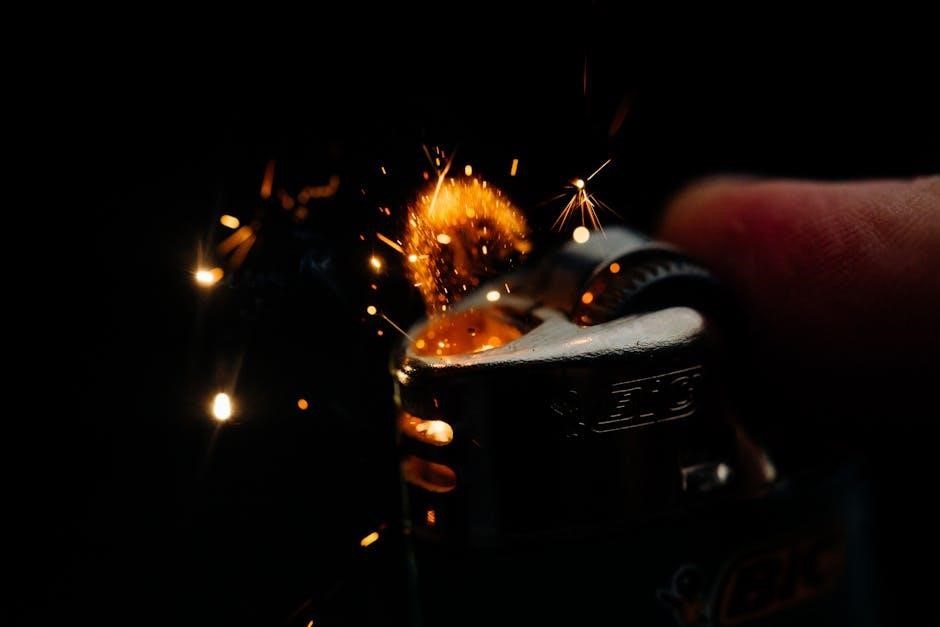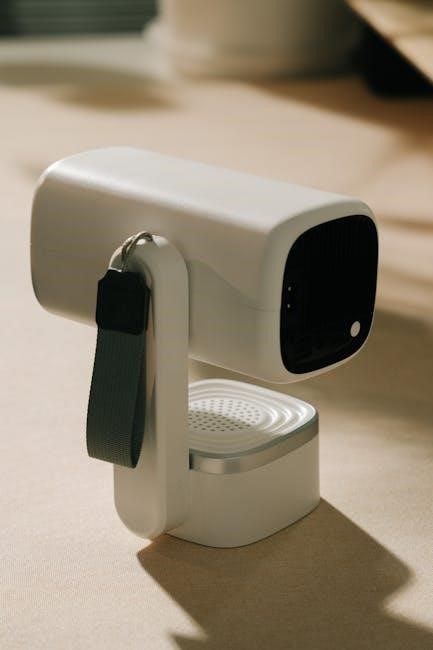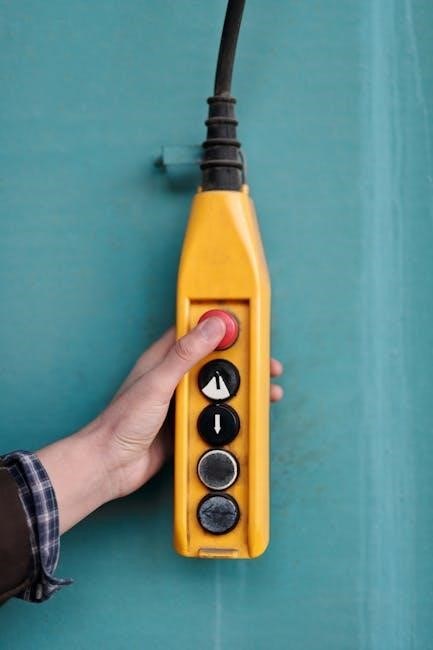Manual fuel pumps are essential components for delivering fuel efficiently in vehicles, especially in classic cars and emergency systems. They offer simplicity and reliability.
1.1 Definition and Purpose
A manual fuel pump is a mechanical device designed to transfer fuel from a storage tank to an engine. Its primary purpose is to ensure a steady fuel supply, especially in vehicles without electronic fuel injection systems. Operated by hand or through engine vacuum, it provides reliability in classic cars, boats, and emergency backup systems. Its simplicity and cost-effectiveness make it a preferred choice for older engines and niche applications where modern electric pumps are unsuitable. Understanding its purpose is key to maintaining fuel efficiency and performance.
1.2 History and Evolution
The manual fuel pump has origins tracing back to early automotive history, evolving from simple hand-operated systems to more refined mechanical designs. Initially used in vintage cars, these pumps relied on basic mechanisms to push fuel through engines. Over time, advancements introduced diaphragm-based systems, enhancing efficiency and durability. Despite modern electric pumps dominating newer vehicles, manual pumps remain popular in classic and specialized applications, reflecting their enduring utility and simplicity. Their evolution mirrors the broader development of automotive technology while retaining core functionality.

Key Components of a Manual Fuel Pump
Manual fuel pumps consist of a diaphragm, valves, inlet and outlet ports, and a fuel chamber within a durable housing, ensuring efficient fuel delivery.
2.1 Diaphragm and Valves
The diaphragm is a flexible, rubber or leather component that creates suction and pressure to draw fuel into the pump. Valves regulate fuel flow, ensuring it moves in one direction. When the diaphragm compresses, it forces fuel through the outlet valve to the engine. The inlet valve opens to refill the chamber with fuel from the tank. This synchronized operation ensures efficient fuel transfer and prevents backflow, maintaining consistent pressure and performance in the fuel system.
2.2 Inlet and Outlet Ports
The inlet port connects the fuel tank to the pump, allowing fuel to flow in, while the outlet port directs pressurized fuel to the engine. These ports are crucial for maintaining proper fuel flow and pressure. Their design ensures minimal restriction and efficient delivery. Correct sizing and alignment are essential for optimal performance. Regular inspection prevents clogging and ensures reliable operation, making them vital components for consistent engine functionality.
2.3 Fuel Chamber and Housing
The fuel chamber stores fuel temporarily before it is pumped to the engine, while the housing protects internal components from environmental factors. Constructed from durable materials like stainless steel or high-grade plastics, these parts ensure longevity and resistance to corrosion. The housing also helps maintain consistent performance by shielding the pump from heat and vibrations. Proper alignment and sealing of the chamber and housing are critical for preventing leaks and ensuring efficient fuel delivery. Regular inspection is recommended to maintain optimal functionality.

How Manual Fuel Pumps Work
Manual fuel pumps operate by creating suction to draw fuel from the tank and push it through the system. A hand-operated lever drives the mechanism.
3;1 Mechanism of Operation
Manual fuel pumps function by leveraging a diaphragm or plunger mechanism. When the operator moves the lever, the diaphragm creates suction, drawing fuel from the tank into the pump’s chamber. As the lever returns to its original position, the diaphragm pushes the fuel through the outlet port and into the engine. This continuous motion ensures a steady fuel supply. The process relies on one-way valves to maintain flow direction, making it both efficient and reliable for various applications.
3.2 Role of the Diaphragm in Fuel Transfer
The diaphragm is a critical component in manual fuel pumps, responsible for creating suction and pressure to transfer fuel. During operation, the diaphragm flexes to draw fuel into the pump chamber and then compresses to push it out through the outlet port. Its elastic nature ensures consistent fuel flow while maintaining system integrity. Over time, wear and tear can affect performance, requiring regular inspection and replacement to prevent fuel leaks or reduced efficiency. Proper maintenance ensures optimal functionality.

Advantages of Manual Fuel Pumps
Manual fuel pumps are known for their simplicity, reliability, and low maintenance requirements, making them cost-effective solutions for various applications, including classic vehicles and emergency systems.
4.1 Simplicity and Reliability
Manual fuel pumps are designed with minimal components, ensuring straightforward operation and reducing the likelihood of mechanical failure. Their reliability stems from durable materials and a robust construction, making them dependable in various conditions. This simplicity also translates to ease of maintenance, as fewer parts mean less complexity in troubleshooting and repairs. Consequently, manual fuel pumps are favored for their consistent performance and minimal downtime, especially in applications where mechanical simplicity is crucial.
4.2 Low Maintenance Requirements
Manual fuel pumps require minimal maintenance due to their straightforward design. With fewer moving parts, they are less prone to wear and tear, reducing the need for frequent servicing. Cleaning and inspecting the diaphragm and valves are typically the only necessary tasks. This simplicity makes them cost-effective and ideal for long-term use in vehicles and marine applications, ensuring consistent performance without extensive upkeep. Their durable construction further minimizes the need for repairs, making them a practical choice for various engines.
4.3 Cost-Effectiveness
Manual fuel pumps are a budget-friendly option for fuel delivery systems. Their simple design reduces production costs, making them more affordable than complex electric pumps. With fewer components, they also lower long-term expenses by minimizing repair and replacement needs. This cost-effectiveness is particularly beneficial for classic vehicles and backup systems, where affordability and reliability are prioritized. Overall, manual fuel pumps provide a practical and economical solution for fuel transfer without compromising performance.
Choosing the Right Manual Fuel Pump
Selecting the ideal manual fuel pump involves assessing flow rate, pressure, and compatibility with your vehicle or engine. Proper matching ensures optimal performance and efficiency.
5.1 Factors to Consider (Flow Rate, Pressure, Compatibility)
When selecting a manual fuel pump, consider flow rate to ensure it matches your engine’s demand. Pressure must align with the system’s requirements to avoid damage. Compatibility is crucial, as it ensures the pump integrates seamlessly with your vehicle’s fuel system. Proper assessment of these factors guarantees optimal performance, preventing issues like insufficient fuel delivery or system overpressure. Always match specifications with your vehicle’s needs for reliable operation.
5.2 Matching Pump Specifications to Vehicle Needs
Matching pump specs to your vehicle ensures efficient fuel delivery and prevents mechanical strain. Start by identifying your engine’s fuel requirements, including flow rate and pressure. Check compatibility with fuel types, as some pumps are designed for specific fuels. Consider the tank size and system layout to choose the right pump size. Proper alignment of these factors ensures smooth operation, maximizes fuel efficiency, and extends the pump’s lifespan. Always refer to your vehicle’s manual for precise specifications. Accurate matching is key to optimal performance.
Proper installation of a manual fuel pump ensures safe and efficient operation. Follow a step-by-step guide and take necessary safety precautions to avoid fuel leaks. To install a manual fuel pump, begin by disconnecting the battery for safety. Next, locate the fuel tank and attach the pump securely. Ensure all connections are tight to prevent leaks. Follow the manufacturer’s instructions for aligning the inlet and outlet ports correctly. Use appropriate tools to avoid damaging components. Finally, test the pump by priming it and checking for proper fuel flow before reconnecting the battery and starting the engine. Safety should always be prioritized. When installing a manual fuel pump, always disconnect the battery to prevent accidental engine start. Ensure the area is well-ventilated to avoid inhaling fuel vapors. Wear protective gloves and goggles to prevent skin and eye irritation. Tighten all connections securely to avoid leaks and potential fires. Avoid smoking or using open flames nearby. Use the correct tools to prevent damage to the pump or fuel system. Test the system slowly to check for leaks before full operation. Follow all manufacturer guidelines for safe installation. Regular cleaning of filters and fuel lines ensures smooth operation. Replace worn diaphragms and valves promptly. Check for leaks and address them immediately to prevent fuel waste. To maintain efficiency, regularly inspect and clean the diaphragm and valves. Use a soft brush to remove debris and ensure all parts are free from contaminants. Replace any worn or damaged components promptly to prevent fuel leaks and performance issues. Always use compatible replacement parts to ensure proper function. Cleaning should be done in a well-ventilated area, away from open flames or sparks to avoid hazards. Proper maintenance extends the pump’s lifespan. Common issues with manual fuel pumps include air leaks, clogged filters, and worn diaphragms. To address air leaks, inspect and tighten all connections. For clogged filters, replace them with new ones. Worn diaphragms should be replaced promptly to maintain proper fuel flow. Regular maintenance and inspections help prevent these issues. Always refer to the manufacturer’s guidelines for specific solutions; Addressing problems early ensures optimal performance and longevity of the pump. Manual fuel pumps are widely used in classic vehicles, boats, and emergency backup systems. They are ideal for reliable fuel delivery in various mechanical applications. Manual fuel pumps are commonly used in classic and vintage vehicles, where simplicity and reliability are crucial. These pumps are preferred for their mechanical operation, eliminating the need for electrical systems. They are often praised for their durability and ease of maintenance, making them ideal for enthusiasts restoring older engines. Their ability to function without modern dependencies ensures they remain a vital component in preserving the authenticity and performance of vintage automotive designs. Manual fuel pumps are widely used in boats and marine engines due to their reliability and simplicity. They provide consistent fuel flow without relying on electrical systems, making them ideal for marine environments. Their low maintenance and durability ensure they perform well in harsh conditions. Additionally, they are cost-effective and easy to repair, making them a preferred choice for both small boats and larger marine vessels. Their mechanical design ensures they can withstand the stresses of marine operations effectively. Manual fuel pumps are valuable in emergency and backup systems due to their reliability without electricity. They ensure fuel delivery during power failures, making them ideal for standby generators and emergency vehicles. Their simplicity and durability provide consistent performance in critical situations. Additionally, they are easy to operate and maintain, ensuring readiness when needed most. This makes them a crucial component in backup systems for both vehicles and stationary equipment. Manual fuel pumps are reliable, cost-effective solutions for fuel delivery in various applications. Their simplicity and durability make them ideal for classic vehicles and emergency systems. Manual fuel pumps are simple, reliable devices designed to transfer fuel efficiently in various applications. They consist of key components like diaphragms, valves, and chambers, ensuring consistent fuel flow. These pumps operate through a straightforward mechanism, making them low maintenance and cost-effective. Ideal for classic vehicles, boats, and emergency systems, manual fuel pumps offer durability and ease of use. Proper installation, regular maintenance, and troubleshooting are essential for optimal performance. Their versatility and reliability make them a preferred choice for many users. Always consider the specific needs of your vehicle or application when selecting a manual fuel pump. Ensure proper installation and regular maintenance to maximize performance and longevity. Inspect diaphragms and valves periodically for wear and tear. Use the correct fuel type recommended for your pump to avoid damage. Keep the pump clean and dry to prevent corrosion. Follow safety guidelines during operation and refer to the manual for troubleshooting. These practices will ensure reliable and efficient fuel delivery.Installation and Setup
6.1 Step-by-Step Installation Guide
6.2 Safety Precautions and Tips
Maintenance and Troubleshooting
7.1 Cleaning and Replacing Parts
7;2 Common Issues and Solutions

Applications of Manual Fuel Pumps
8.1 Use in Classic and Vintage Vehicles
8.2 Application in Boats and Marine Engines
8.3 Emergency and Backup Systems
9.1 Summary of Key Points
9.2 Final Tips for Users



























































